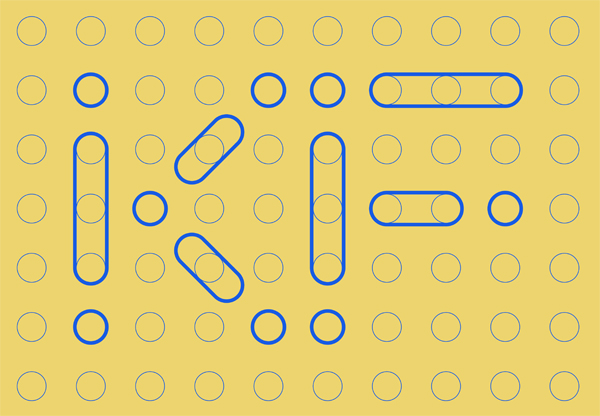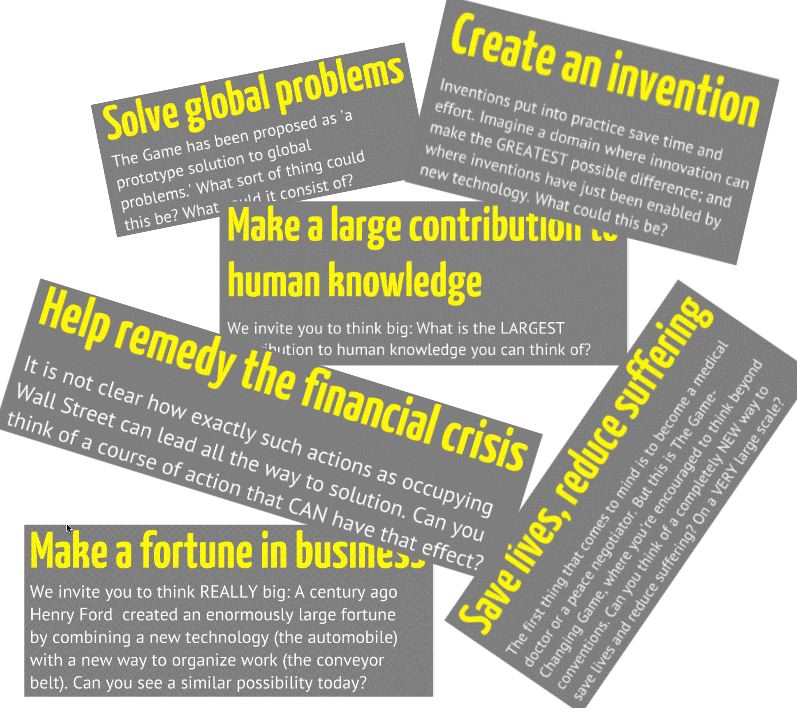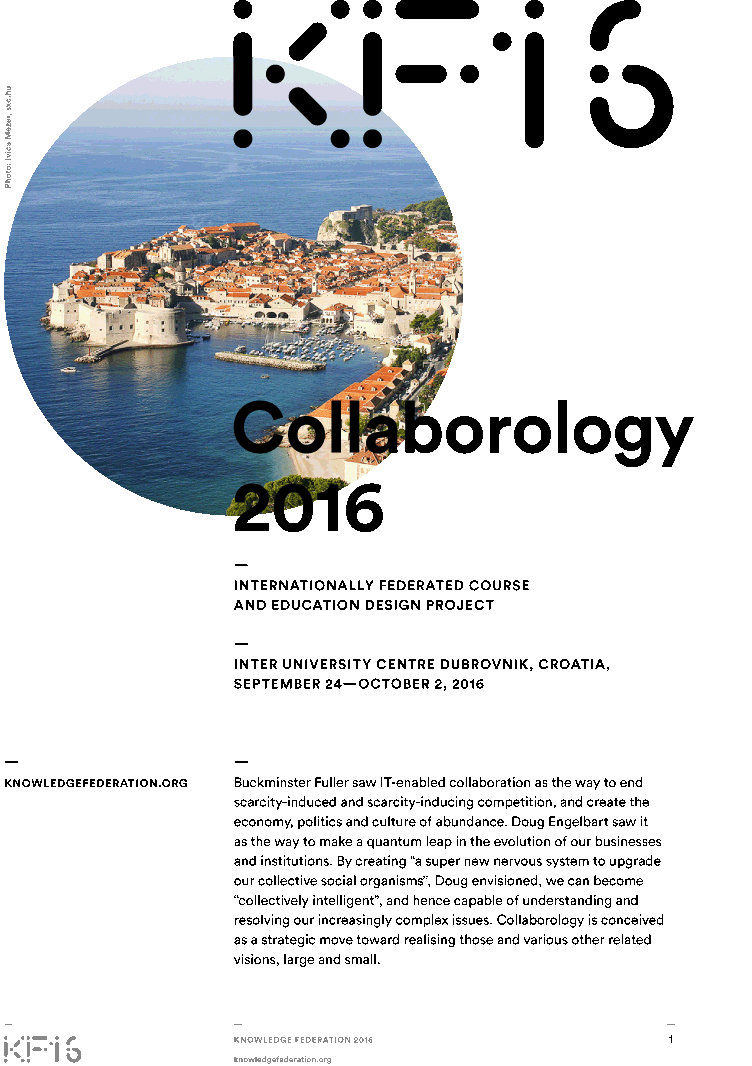N-prototypes
Contents
Federation through Prototypes
(Alexander Laszlo, call to action at International Society for the Systems Sciences yearly conference, Haiphong 2013)
"The tie between information and action has been severed", Neil Postman warned in his 1990 keynote Informing Ourselves to Death.
Prototypes restore the severed tie between information and action.
If you think of the overloads of (academic) information that is produced and not acted on—or even comprehended, or even seen—then you'll easily understand what the prototypes are for. In an academic paradigm where information is a system within a system, and where we use our creative powers to improve the systems (in which we live and work)—prototypes are the characteristics products of our creative efforts; as academic books and articles are in the present paradigm.
A prototype is
- a model, functioning in reality, exhibiting a collection of challenge–solution pairs, or design patterns as we are calling them; and showing how to combine those design patterns in a coherently functioning whole
- an intervention, strategically designed to alter certain conventional practice or system
- an experiment, showing what in the proposed design works well, and what needs to be improved.
A prototype is not complete unless it has a clear and realistic impact model and a deployment plan.
In knowledge
The knowledge federation prototype shows how the society can evolve knowledge-based.
This prototype is conceived as the society's evolutionary organ; enabling the insight that were developed in academic fields, and those that emanated from the world traditions—to impact not only how we the people see and comprehend the world—but the world itself!
Systems scientist Bela H. Banathy wrote in Designing Social Systems in a Changing World:
“I have become increasingly convinced that [people] cannot give direction to their lives, they cannot forge their destiny, they cannot take charge of their future—unless they also develop the competence to take part directly and authentically in the design of the systems in which they live and work, and reclaim their right to do so. This is what true empowerment is about.”

The knowledge federation prototype enables knowledge-based systemic change.
A prototype of a system is created, and a transdiscipline around it—to update it and give it real-life impact; according to the state-of-the-art disciplinary and other insights that everyone brings along. Knowledge federation creates the transdiscipline by creating itself.
As a system that turns information into meaning.
But knowledge federation also has an academic side; where a way to empower the next-generation scientists to be creative in ways that their situation demands is modeled; and also a way to bring the academic tradition into the next stage of its evolution.
And also, and importantly—knowledge federation models a creative frontier.
Having found ourselves in a realm of creative opportunities and challenges immensely larger than what we ourselves could develop, we worked in the manner of prospectors—and endeavored to chart it and structure it by creating prototypes; and in that way enable and streamline large-scale development.
The knowledge federation prototype has been conceived in terms of about forty smaller prototypes; which model new ways to implement all those various parts and functions that constitute a discipline—ranging from epistemology and methodology to a community of state-of-the-art experts and examples of application. Together those prototypes compose a coherent whole—a prototype of a functioning transdiscipline.
In information
How can I do justice to the Innovation Ecosystem for Good Journalism prototype we created in Barcelona in just a few lines? I’ll just highlight a couple of (design questions that define) its design patterns:
- What should information (that empowers the post-industrial democracy to see and follow a viable course) be like; and who and how will create it?
- How should public informing as a system be structured; and who and how will create it?
Information must turn perceived problems into systemic action.
The system of public informing we envisioned as two loops forming the number 8; where the lower loop identifies and curates problems (we empowered the people to do this directly; by building on Barcelona's WikiDiario citizen journalism project); and where the upper loop identifies (by engaging academic and other experts) and communicates (through the agency of knowledge federation's communication design team) their systemic solutions. "How else would we know", I explained in the Liberation book, "that 'corporate personhood' could be an issue?"
Our Barcelona prototype prototyped also a system by which journalism could be created and perpetually re-created.

We were fortunate to have with us Paddy Coulter (director of Oxford Global Media and former director of Oxford University Reuters School of Journalism); who had also been a keynoter at our formative 2010 workshop in Dubrovnik. In the manner of giving the good journalism tradition the reigns, we asked Paddy to chair the Barcelona event.
We techies should not allow ourselves to reinvent journalism.
Our task was to facilitate its evolution—by federating transformative memes. In Barcelona workshop Mei Lin Fung (founder of the Silicon Valley-based initiative to continue and complete Doug Engelbart's vision called Program for the Future) represented the Doug Engelbart legacy; David Price (co-founder of Debategraph as the leading collective mind initiative, and of Global Sensemaking as the global community of collective mind researchers and developers) led the technology team.
In empowerment
As an experiment, the prototype we crafted in Barcelona gave us an invaluable insight: When the journalists who co-created it with us returned to their busy editorial desks—they were out of sight! This helped us realize that the people who have power positions within a system will not be the one who can change that system; they are too busy running it!

A system that can change systems must be conceived differently!
And so the following year, at our 2012 Palo Alto workshop, we crafted a prototype of a system called the game-changing game; and presented it at the Bay Area Future Salon.
The game-changing game is not a game in ordinary sense, but a game-changing way to have a career; where instead of playing by the rules, instead of trying to fit in an existing profession or system—the players undertake to change a system. The game-changing game has two categories of players: The A-players (who as graduate students, or entrepreneurs in search of a project) are in a career and life phase where change is natural and easy; and the Z-players (who as professors, or investors) are in positions of power.
The Z-players play the game-changing game by empowering the A-players to pursue their career goals by changing a system.
In 2012 in Zagreb we created the club of Zagreb—a redesign of The Club of Rome based on the game-changing game.
In education
Education is already the society's evolutionary organ.
Which recreates the world with every new generation; unless, of course, it's conceived as a way to pull "the world" over their eyes; and press them into the mold of our already obsolete systems, and professions.
The collaborology prototype models an education that can make the difference.

Here too I'll only mention two of its design patterns.
In the collaborology prototype education is by pull, not push.
Which translates into a whole spectrum of advantages—by developing creativity, and collaboration ethics and skills, and other personality traits that are so much in need; and by enabling education to be life-long and need or interest-based
The collaborology course is internationally federated.
By enabling—through suitable use of new technology—everyone in the world to participate in the course as (both!) students and instructors. Which translates into another spectrum of advantages—including that it enables (provides a sustainable business model for) the creation of a (new) transdiscipline; and engenders the economies of scale that are characteristic of systemic innovation (instead of teaching the whole course, each instructor is responsible only for a single module).

